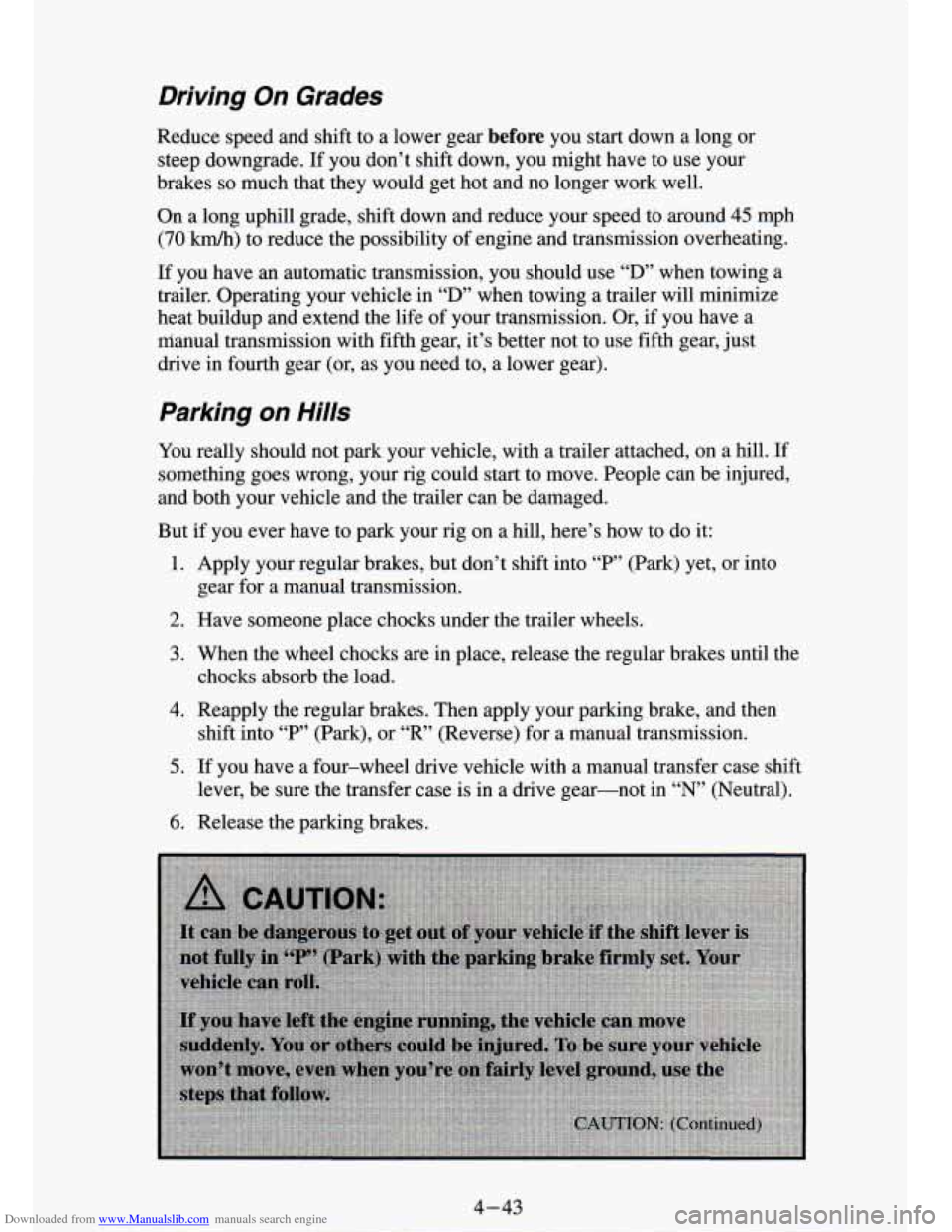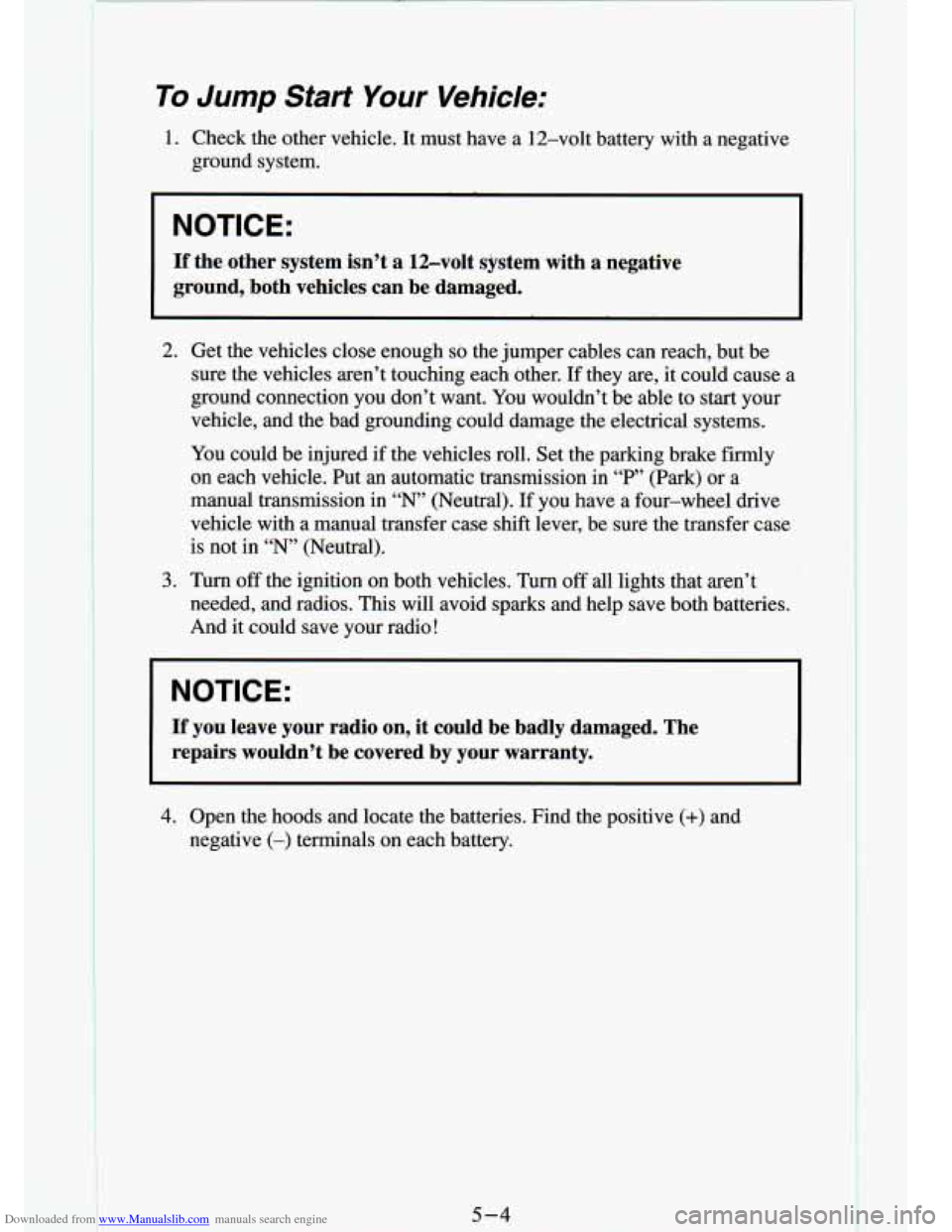Page 179 of 340

Downloaded from www.Manualslib.com manuals search engine Driving On Grades
Reduce speed and shift to a lower gear before you start dawn a long or
steep downgrade. If you don’t shift down, you might have to use your
brakes
so much that they would get hot and no longer work well.
On a long uphill grade, shift down and reduce your speed
to around 45 mph
(70 km/h) to reduce the possibility of engine and transmission overheating.
If you have an automatic transmission, you should use “D” when towing a
trailer. Operating your vehicle
in “D” when towing a trailer will minimize
heat buildup and extend the life of your transmission.
Or, if you have a
rrianual transmission with fifth gear, it’s better not to use fifth gear, just
drive in fourth gear (or, as
you need to, a lower gear).
Parking on Hills
You really should not park your vehicle, with a trailer attached, \
on a hill. If
something goes wrong, your rig could start to move. People
can be injured,
and both your vehicle and the trailer can be damaged.
But if you ever have
to park your rig on a hill, here’s how to do it:
1. Apply your regular brakes, but don’t shift into “P” (Park) yet, or into
2. Have someone place chocks under the trailer wheels.
3. When the wheel chocks are in place, release the regular brakes until the
gear
for
a manual transmission.
chocks absorb the load.
4. Reapply the regular brakes. Then apply your parking brake, and \
then
shift into
“P” (Park), or “R” (Reverse) for a manual transmission.
5. If you have a four-wheel drive vehicle with a manual transfer \
case shift
lever, be sure the transfer case is
in a drive gear-not in “N” (Neutral).
6. Release the parking brakes,
4-43
Page 186 of 340

Downloaded from www.Manualslib.com manuals search engine I E
To Jump Start Your Vehicle:
1. Check the other vehicle. It must have a 12-volt battery wlm a\
negauve
ground system.
NOTICE:
If the other system isn’t a 12-volt system with a negative \
ground, both vehicles can be damaged.
2. Get the vehicles close enough so the jumper cables can reach, but be
sure the vehicles aren’t touching each other. If they are, it could cause
a
ground connection you don’t want. You wouldn’t be able to start your
vehicle, and the bad grounding could damage the electrical syst\
ems.
You could be injured if the vehicles roll, Set the parking brake
firmly
on each vehicle. Put an automatic transmission in “P” (Park)\
or a
manual transmission
in “N’ (Neutral). If you have a four-wheel drive
vehicle with
a manual transfer case shift lever, be sure the transfer case
is not in “N’ (Neutral).
3. Turn off the ignition on both vehicles. Turn off all lights t\
hat aren’t
needed, and radios. This will avoid sparks and help save both batteries.
And it could save your radio!
I NOTICE:
I
If you leave your radio on, it could be badly damaged. The
repairs wouldn’t be covered by your warranty.
4. Open the hoods and locate the batteries. Find the positive (+) and
negative
(-) terminals on each battery.
5-4
I
Page 190 of 340
Downloaded from www.Manualslib.com manuals search engine Towing Your Vehicle
Try to have a GM dealer or a professional towing service tow your vehicle.
They can provide the right equipment and know how to tow it without
damage.
If your vehicle has been changed since
it was factory-new by adding things
like fog lamps, aero skirting, or special tires and wheels, these things\
could
be damaged during towing.
Before you do anything, turn on the hazard warning flashers.
When you call, tell the towing service:
That your vehicle has rear-wheel drive, or that it has the four-wheel
0 The make, model, and year of your vehicle.
Whether you can move the shift lever for the transmission and shift the
drive option.
transfer case, if you have one.
If there was an accident, what was damaged.
5-8
Page 191 of 340
Downloaded from www.Manualslib.com manuals search engine When your vehicle is being towed, have the ignition key off. The steering
wheel should be clamped in a straight-ahead position
with a clamping
device designed for towing service.
Do not use the vehicle’s steering
column lock for this. The transmissi,on (either automatic or manual) should
be
in “N’ (Neutral) and the transfer case (either manual shift or electronic
shift),
if you have one, should be in 2 HI. The paking brake should be
released.
5-9
Page 192 of 340
Downloaded from www.Manualslib.com manuals search engine Towing From fhe Front
NOTICE:
Do not tow with sling-type equipment or front bumper system
will be damaged.
Use wheel lift or car-carrier equipment.
Additional ramping may be required for car-carrier equipment.
Use safety chains and wheel straps.
If your vehicle has the four-wheel drive option, a dolly MUST be
used under the rear wheels when towing from the front.
5-19
Page 193 of 340
Downloaded from www.Manualslib.com manuals search engine Towing From the Rear
NOTICE:
Do not tow with sling-type equipment or rear bumper system
will be damaged.
Use wheel lift or car-carrier equipment.
Additional ramping may be required for car-carrier equipment.
: . .A. :i.-.
Use safety chains and wheel straps.
If your vehicle has the four-wheel drive option, a dolly MUST
be used under the front wheels when towing from the rear.
Don’t have your vehicle towed on the rear wheels, unless you have to. If the
vehicle must be towed on the rear wheels, don’t go more th\
an
35 mph (56
km/h) or farther than 50 miles (80 km) or your transmission will be
damaged.
If these limits must be exceeded, then the rear drive wheels have
to be supported on a dolly.
5-11
Page 202 of 340

Downloaded from www.Manualslib.com manuals search engine If a Tire Goes Flat
It’s unusual for a tire to “blow out” while you’re driving, especially if you
maintain your tires properly. If
air goes out of a tire, it’s much more likely to
leak out slowly. But if you should ever have a “blowout,”\
here are a few tips
about what to expect and what
to do:
If a front tire fails, the flat tire will create a drag that pulls the vehicle
toward that side. Take your foot
off the accelerator pedal and grip the
steering wheel firrnly. Steer to maintain lane position, then g\
ently brake to a
stop well out of the traffic lane.
A rear blowout, particularly on a curve, acts much like a skid \
and may
require the same correction you’d use in a skid.
In any rear blowout, remove
your foot from the accelerator pedal. Get the vehicle under co\
ntrol by
steering the way you want the vehicle to go. It may be very bumpy and
noisy, but you can still steer. Gently brake to a stop, well \
off the road if
possible.
If a tire goes flat, the next part shows how to use your jacking equipment to
change a flat tire safely.
Changing a Flat Tire
If a tire goes flat, avoid further tire and wheel damage by driving slowly to a
level place. Turn on your hazard waming flashers.
5-20
Page 203 of 340
Downloaded from www.Manualslib.com manuals search engine Flat Tire
L Blocked Tire
The following steps will tell you how to use the jack and change a tire.
Jack Storage
Your jack, wheel wrench and wheel blocks are stored behind the front seats,
either on the center wall (extended cab) or along the right wall (regular \
cab).
To remove your jack
cover, if you have one,
turn the plastic wing
nut to the left until
you can pull it out.
Remove the jack
cover.
To remove the wheel
blocks, jack and wheel
wrench,
turn the wing
nut to the left. Pull the
wheel blocks, jack and
wheel wrench
off.
5-21